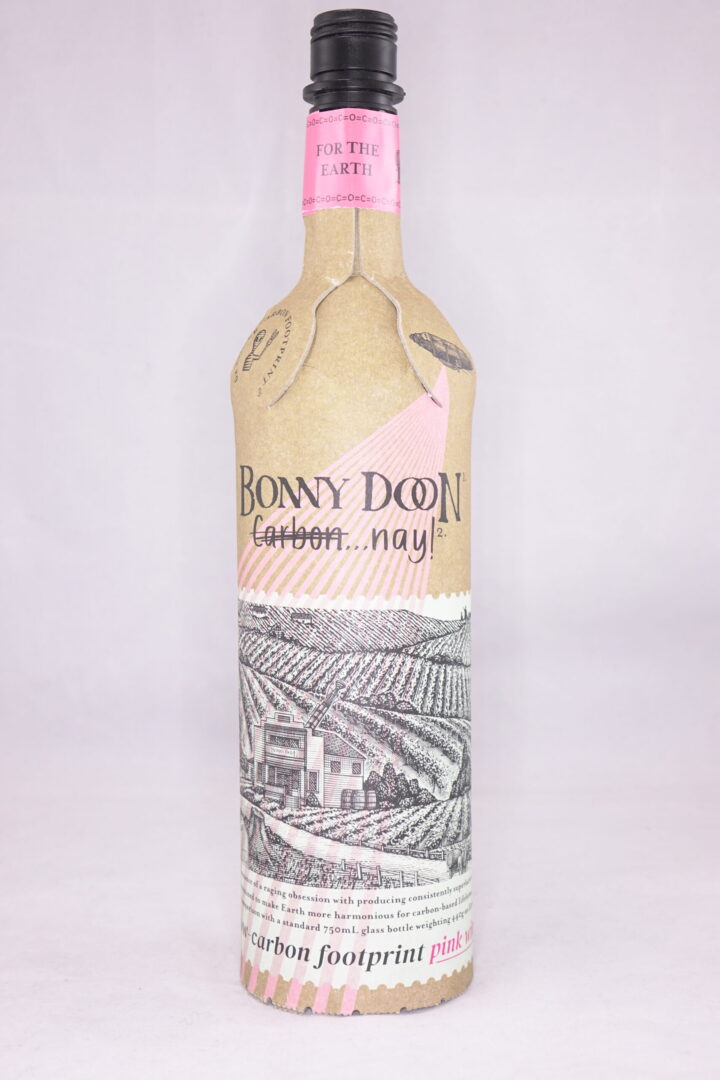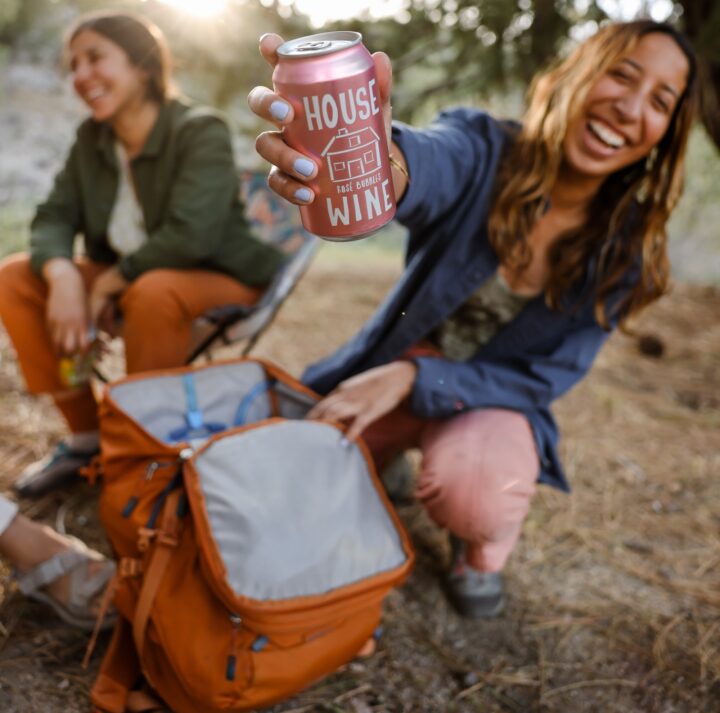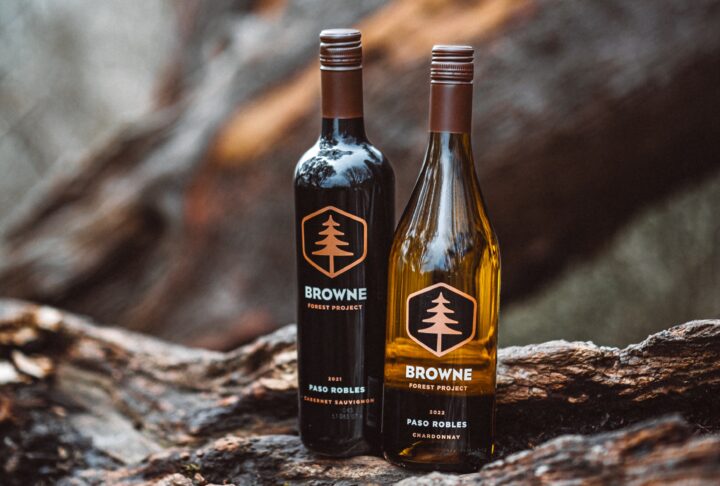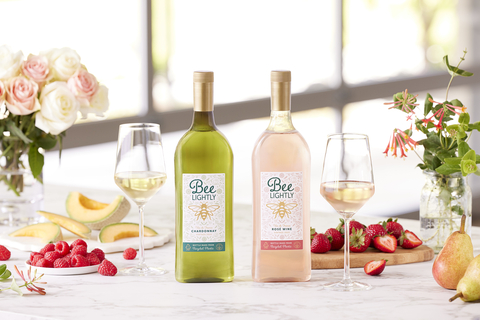![In an effort to become more sustainable, wine brands like Element[AL] and FitVine (lineup above) are switching from glass bottles, which are the largest contributor to wine’s carbon footprint, to aluminum bottles. Both brands have seen success with the new packaging.](https://mscwordpresscontent.s3.amazonaws.com/mwmag/wp-content/uploads/2025/09/FitVine_Active_Bottles_Hero_Shot-720x360.jpg)
In January 2024, Bogle Family Wine Collection introduced a new wine line, Element[AL] Wines, with a packaging shift that drew attention from both the trade and consumers. The wines are packaged in 750-ml. aluminum wine bottles that are “lightweight, infinitely recyclable, and are made in the shape of a traditional wine bottle,” says vice president of consumer relations Jody Bogle, citing environmental stewardship as a key factor in the new bottle format for Element[AL]. “It’s widely known in the wine industry that glass bottles are the largest contributor to wine’s carbon footprint, so we began exploring ways we could help move the industry forward with a radical new approach,” she says. “This led us to aluminum, which blends the form and sophistication of the traditional glass bottle with go-anywhere, lightweight functionality.”
O’Neill Vintners & Distillers followed a few months later with aluminum bottle packaging for its FitVine line of wines. The packaging—lightweight, resealable, and unbreakable—targets “outdoor enthusiasts and urban adventurers” and drinking occasions beyond the dinner table. “We’re trying to drive forward on convenience and [appealing to] active consumers,” says vice president of marketing Blaire Fraser. Citing occasions such as hiking, lounging by the pool, or at the beach, she touts the convenience of resealable aluminum bottles and also notes they “deliver on some of the sustainability messages that we’re trying to drive at O’Neill.”
Albertsons Cos. had a different approach. Last fall, the supermarket chain launched a private label wine called Bee Lightly in a bottle made from 100% recycled polyethylene terephthalate (PET), which the company says is 87% lighter than the material used for traditional glass bottles. The bottles are unusually shaped—flat pack rather than round—which allows for a smaller environmental footprint and nearly doubles the number of bottles on a single shipping pallet. “The introduction of Bee Lightly into our Own Brands portfolio marks an innovative partnership and venture into wine packaging, highlighting our dedication to product quality and environmental stewardship,” Brandon Brown, senior vice president of Own Brands at Albertsons Cos., said at the product launch in late September.

Exclusively at Whole Food Markets, Bonny Doon Vineyard’s Carbon…Nay! wine is packaged in a paper bottle. Created by packaging company FrugalPac, the paperboard exterior houses a PET pouch to hold the Central Coast pink wine blend. “The new packaging aligns perfectly with our own efforts to create a more sustainable and transparent wine industry, and what our customers are growing to expect from key leaders in this space,” Kara Chavez, principal category merchant of adult beverage at Whole Foods Market, said at the May 2024 launch.
Moves by Bogle Family Vineyards, O’Neill Vintners & Distillers, Albertsons, and Bonny Doon are just some of the many initiatives taken by winemakers to change up the traditional 750-ml. glass bottle packaging that has been synonymous with wine for decades. Some changes are made for environmental purposes, others are simply responding to consumer demands for a broader array of packaging options. Glass bottles still dominate, but alternative packaging is making headway. “Glass wine bottles are certainly still perceived to be the most traditional and elegant solution to have on your table, serve guests, or give as gifts,” notes Phillip Cleveland, brand director at Ste. Michelle Wine Estates. “Whereas alternative formats are considered to be more suitable for causal and informal occasions and outdoor settings.” Cleveland also notes that the company’s internal research shows that consumers ages 25-49 are most open to alternative packaging.

Traditional Alternatives
Alternatives to the standard 750-ml. glass bottle also include boxed wine, which has thrived in the 3-liter format and also is available in various other sizes, while tetra packs and single-serve cans fill a niche for on-the-go wine consumption. Kathy Pryce, vice president of marketing for Delicato Family Wines, says 3-liter boxes continue to thrive. Customers are also enthused about select alternatives. “The 500-ml. tetras—our consumers are just loving that format. The whole 500 milliliter is up 11%, and our go-to mini offerings are up 18%.”
For Ste. Michelle Wine Estates, single-serve cans used for its 14 Hands wine brand have been the company’s most successful alternative packaging, Cleveland says. “Our consumers appreciate the quality, value, flavor-forward style, and accessibility that 14 Hands cans offer,” he says, adding that “We are also seeing growth with our TopBox wine brand, which offers Washington varietal wines in a highly accessible value-oriented 3-liter format. “Our research has shown that consumers ages 25-49 are most open to alternative packaging,” Cleveland continues. “We’ve also seen those who are new to wine and just starting on their wine journey being especially receptive to a variety of formats, as well as consumers who are eco-conscious.”
Precept Wines has long been in the alternative packaging mix with boxed and canned wines under the House Wine label. Precept CMO Alex Evans notes the company committed early—in the early 2000s—to boxed wine, and also offers House Wine in cans. The label was first available in the 355-ml. format and more recently in the single-serve 200-ml. format. Evans says the alternatives are targeted at all consumers, especially those who are drinking wine in on-the-go situations. But like Cleveland, she sees broader acceptance among consumers who are newer to wine. “I think providing wine in an easily transportable thing is important for any wine consumer, but definitely the younger generations are quicker to adapt and gravitate to that,” she says.
![The updated aluminum packaging for Element[AL] wines looks just like a traditional 750-ml. bottle, but it’s lightweight, infinitely recyclable, and more functional than traditional glass.](https://mscwordpresscontent.s3.amazonaws.com/mwmag/wp-content/uploads/2025/09/ELEMENTAL_Pinot_Grigio-720x829.jpg)
Limited Reach
Those traditional alternatives have been embraced—at varying levels—by both the trade and consumers, but their reach is limited, retailers say. Adithya Bathena, CEO of Jersey City, New Jersey-based Buy-Rite Liquors, says 3-liter boxes gained significant traction during the pandemic and are still doing well. “I think it hits the sweet spot for value and convenience since a consumer can have a glass or two at a time and still have the package be fresh for a few weeks.” At Buy-Rite, “4-liter jugs and 5-liter boxes are definitely going down in volume every year and the consumers for those packages are looking for extreme value.
“Cans had their moment, but they’re only for specific occasions like boats and pools and you see them in concerts and planes now, where you don’t really have a choice,” Bathena continues. “I have seen some plastic bottles for pool use, but the world also seems to be moving away from plastic and recyclable glass seems to be the favored bottle for all types of beverages.” Ultimately, he says, “I think customers still much prefer standard glass bottles.”
At Austin-based Twin Liquors, there wasn’t a strong consumer shift in packaging preferences in 2024, according to chain product planning manager Josh Minton. “We did continue to see positive growth on small formats,” he says. Jim Shpall, CEO of Colorado’s Applejack Wine & Spirits, meanwhile, says canned wine has resonated with his customers, but that’s about it. “Beyond the single serving can, consumers still want the old-fashioned 750-ml. glass bottle,” he says.

Industry Lightweights
The 750-ml. glass bottle, of course, remains the predominant packaging option for wine. One action being taken by a broad swath of wineries is simply a reduction in the weight of the bottles. Precept Wines, for example, is making changes to traditional bottles. “We’ve been moving as much of our portfolio as possible towards more sustainable packaging, and we’re leading that effort with lightweight glass,” says Precept’s Evans. “We’re actually in the midst of a glass transition across our entire portfolio and almost across the board we are switching to lighter weight molds.”
Evans says how and if the changes are communicated depends on the brand. Browne Family Vineyards, for example, has an ongoing initiative called the Browne Forest Project with the environmental non-profit One Tree Planted. The broad-based environmental initiative involves the winery planting trees—200,000 of them as of April 2024—but bottle changes were also made. Since the inception of the project in 2022, bottles are 31% lighter than a standard wine bottle, shipping cartons are sourced from responsibly managed forests, and each bottle is label-free, both to save paper and to ensure the bottle is recyclable.
When communicating Browne Family Vineyards wine attributes to consumers, “the lightweight glass initiative is right up front toward the consumer,” Evans notes. “It’s a commitment that our company is making, and it’s not something that necessarily translates to the consumer.”
Many other prominent wine brands have bottle weight reductions as well. Napa Valley’s Cuvaison winery last year began transitioning its portfolio of wines to a new custom lightweight bottle. The new bottle reduces the overall bottle weight by 27% and eliminates the use of foil capsules. “As a winery that embraces sustainability as one of our core values, this was a very important initiative for Cuvaison,” says president and CEO Daniel Zepponi. “It’s been estimated that anywhere from 40%-68% of the wine industry’s carbon footprint comes from glass packaging and transport, so the new bottle—combined with streamlined and consolidated manufacturing and shippings—will dramatically reduce our carbon emissions.” In fact, many if not most California wineries have undertaken steps to reduce the weight of their wine bottles—it’s a highly touted element of efforts by many to move toward carbon neutrality. If consumers notice at all, they don’t seem to care, as marketers report little or no consumer pushback on the changes.

Retailers have mixed reactions. Shpall, for example, says his team hasn’t seen much if any consumer push-back. “But the weight of the glass still serves as a marketing tool and does consciously or subconsciously matter to some consumers especially for high end wines,” he says. “Greater weight adds to the image of being a high-end wine.”
Minton agrees that “the consumer base still sees weight as a signifier of value,” but he acknowledges that “younger consumers absolutely care” about the environmental impact of products they choose. In fact, Buy-Rite’s Bathena believes that most consumers don’t care about the weight of the bottle, but there’s opportunity to appeal to those who do. “It wouldn’t hurt to mention that or to use that as a selling tactic,” he says.
In fact, communicating exactly what’s in the bottle may be the next step, at least for some wineries. Since wine is regulated under the Alcohol and Tobacco Tax and Trade Bureau, it’s not subject to the same labeling laws of the Food and Drug Administration, which requires ingredients and nutrition information on food labels. But some wine companies are starting to make voluntary changes. A year ago, Sokol Blosser Winery began adding nutrition and ingredient information to its back labels in a bid for increased transparency. “More consumers—especially younger consumers—want to know not only where their wine comes from, but what’s in it,” company president Alex Sokol Blosser said at the time. “Why not give the people what they want?”
Precept Wines is also making changes. “We’ve taken a really sharp look at all of our existing brands to figure out how can we provide more information and transparency to consumers,” Evans says. In a new packaging move, each can of House Wine will offer “key transparent information on every single can, including calories. It’s something where the industry’s starting to dip its toe in the water,” Evans says. “It’s a big shift, but we feel that it’s really important to provide that transparency to consumers. We believe they really care about it deeply, especially younger consumers.”